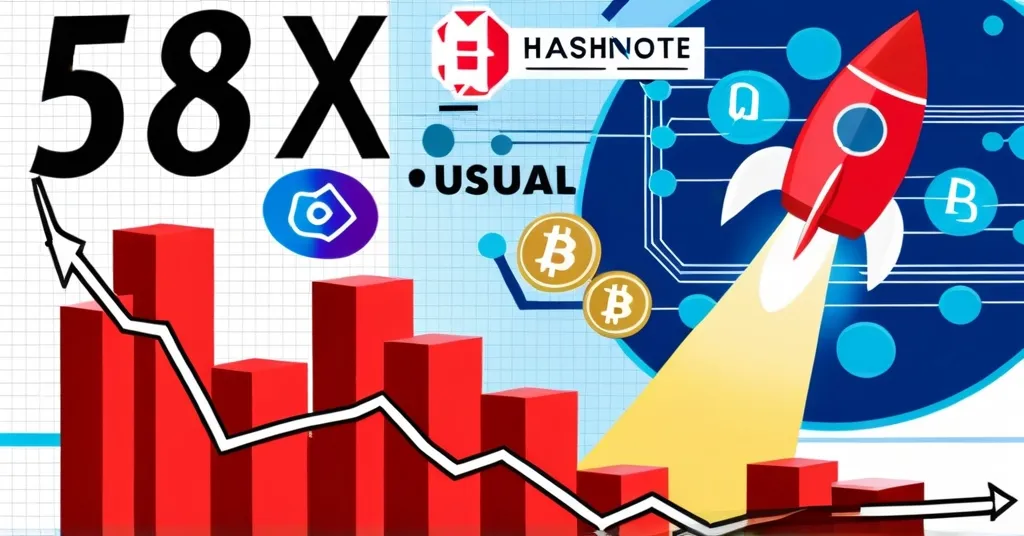RWA Tokenization Soars: TVL Up 58X in 3 Years, Led by Hashnote and Usual

RWA Tokenization Explodes: TVL Soars 58X in Three Years
The real-world asset (RWA) sector has seen its total value locked (TVL) skyrocket by 58 times over the past three years, reaching an impressive $8.217 billion. This surge is driven by key players like Hashnote and Usual, but not all platforms are riding the wave, with some experiencing significant declines. RWA tokenization, the process of converting real-world assets into digital tokens on a blockchain, is transforming asset management and attracting major players like BlackRock into the space.
- RWA sector TVL up 58 times in 3 years
- Hashnote and Usual lead the surge
- Usual raises $10M, token price soars after hack
- Some platforms face declines
- Cardano and BlackRock enter RWA tokenization
Leaders in RWA Tokenization
Hashnote and Usual are at the forefront of this explosive growth. Hashnote boasts a TVL of $1.497 billion, with a 65.58% weekly increase and a 217% surge over the last 30 days. Usual isn’t far behind, securing a TVL of $1.445 billion, with a 65.65% weekly jump and an impressive 230% growth over the same period. Usual’s success is further fueled by a $10 million Series A funding round led by Binance Labs and Kraken Ventures, known for their strategic investments in promising blockchain projects. This influx of capital is set to propel Usual to new heights.
But it’s not just about the numbers; it’s about the stories behind them. Usual’s governance token hit an all-time high following an alleged social media hack involving Vivek Ramaswamy, a figure known for his role in government efficiency. In the wild west of crypto, even a hack can be a stroke of luck—or a stroke of genius, depending on who you ask.
Setbacks and Challenges
Yet, the RWA landscape isn’t all sunshine and rainbows. Platforms like Solv Protocol, DigiFT, Danogo, KlimaDAO, Fortunafi, and Maker RWA have seen their TVLs decline. Maker RWA took a particularly hard hit, dropping 65% over 30 days. It’s a harsh reminder that in the rollercoaster of DeFi, the highs can be as dizzying as the lows are brutal. The rapid growth and volatility can be as much a sign of speculative frenzy as it is of genuine innovation.
These declines highlight the risks inherent in RWA tokenization, from smart contract vulnerabilities to market liquidity issues. As champions of decentralization and privacy, we must remain vigilant against the scammers and the hype that often accompany such booms.
Innovative Applications
On the innovation front, the Argentine lithium mining sector is exploring RWA tokenization using Cardano, a blockchain known for its scalability and sustainability. This move showcases the potential for blockchain to revolutionize real-world industries. Meanwhile, financial giant BlackRock has launched its BUIDL initiative, signaling a growing mainstream acceptance of tokenized assets. BlackRock’s collaboration with Securitize on tokenized fund offerings across multiple blockchains underscores the sector’s growth and mainstream adoption.
Other players like Nest Staking, MatrixDock, Franklin Templeton, and Ethena are also making waves, contributing to the sector’s overall growth. It’s clear that RWA tokenization is not just a trend but a potential shift in how we manage and interact with traditional assets.
Regulatory Challenges and Future Prospects
As RWA tokenization gains traction, regulatory hurdles loom large. The complexities of converting real-world assets into digital tokens necessitate a robust regulatory framework. BlackRock’s initiatives, for instance, navigate exemptions under the Securities Act and the Investment Company Act, highlighting the need for clear guidelines to foster innovation while protecting investors.
Looking ahead, the future of RWA tokenization seems bright yet fraught with challenges. The integration of blockchain technology into traditional asset management could bridge the gap between decentralized finance and conventional markets. However, this potential shift requires careful risk management strategies, such as smart contract audits and liquidity management, to ensure the sector’s sustainable growth.
So, is RWA tokenization the bridge that will finally connect traditional finance with the decentralized world? Or is it just another bubble waiting to burst? Only time will tell, but one thing is certain: the RWA sector is a frontier that’s too exciting—and too important—to ignore.
Key Takeaways and Questions
- What is the current total value locked in the RWA sector?
The current TVL in the RWA sector stands at $8.217 billion.
- Which platforms have been leading the growth in the RWA sector?
Hashnote and Usual have been at the forefront, with significant TVL increases.
- How has Usual’s governance token been affected recently?
Usual’s governance token reached a new all-time high following a social media hack involving Vivek Ramaswamy.
- Which platforms have experienced declines in the RWA sector?
Platforms such as Solv Protocol, DigiFT, Danogo, KlimaDAO, Fortunafi, and Maker RWA have faced declines.
- What are some examples of RWA tokenization outside of the leading platforms?
The Argentine lithium mining sector is using Cardano for RWA tokenization, and BlackRock has launched its BUIDL initiative.
- What does the rise in RWA tokenization suggest for the future of asset management?
The rise in RWA tokenization indicates a potential shift towards integrating blockchain technology into traditional asset management practices.



